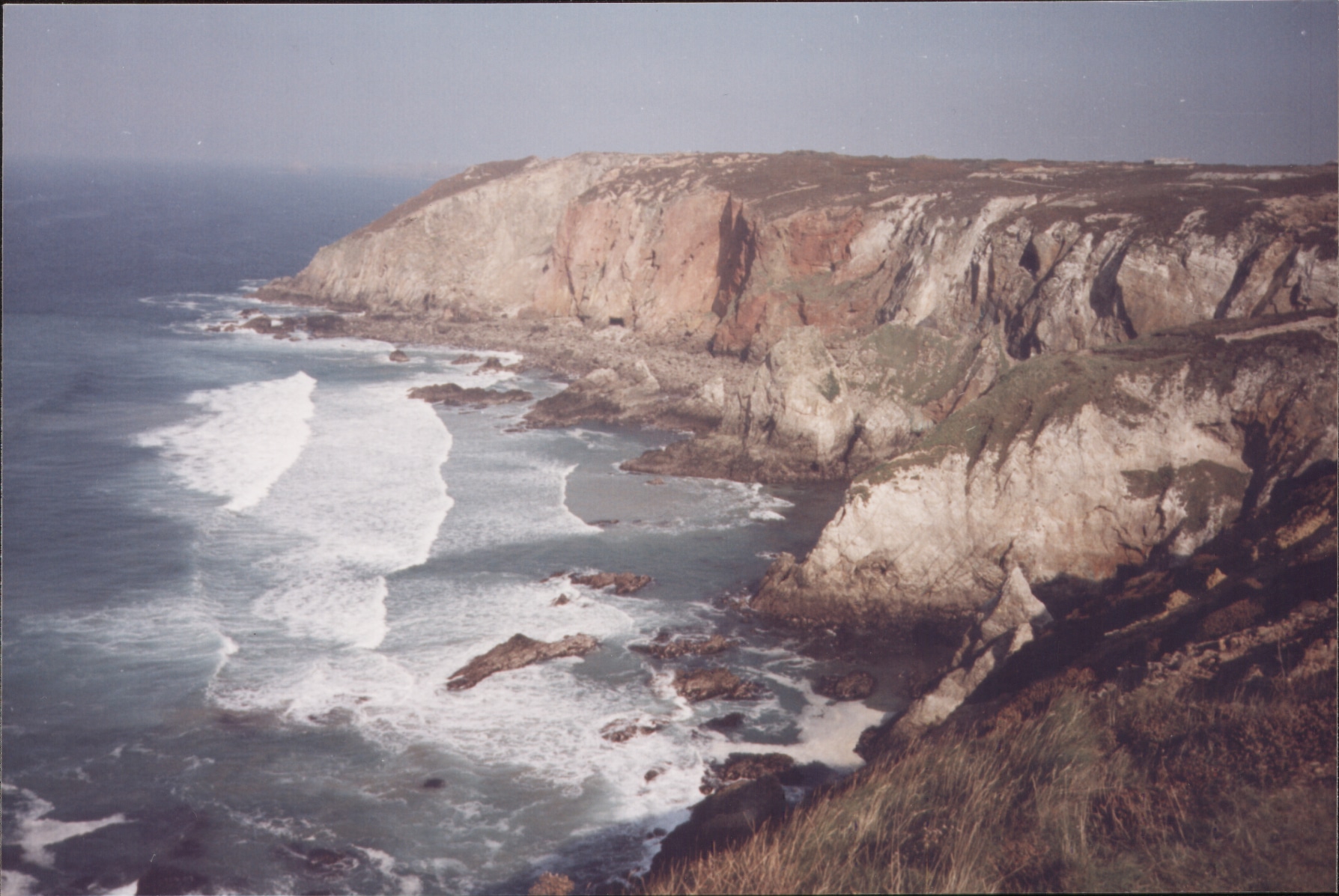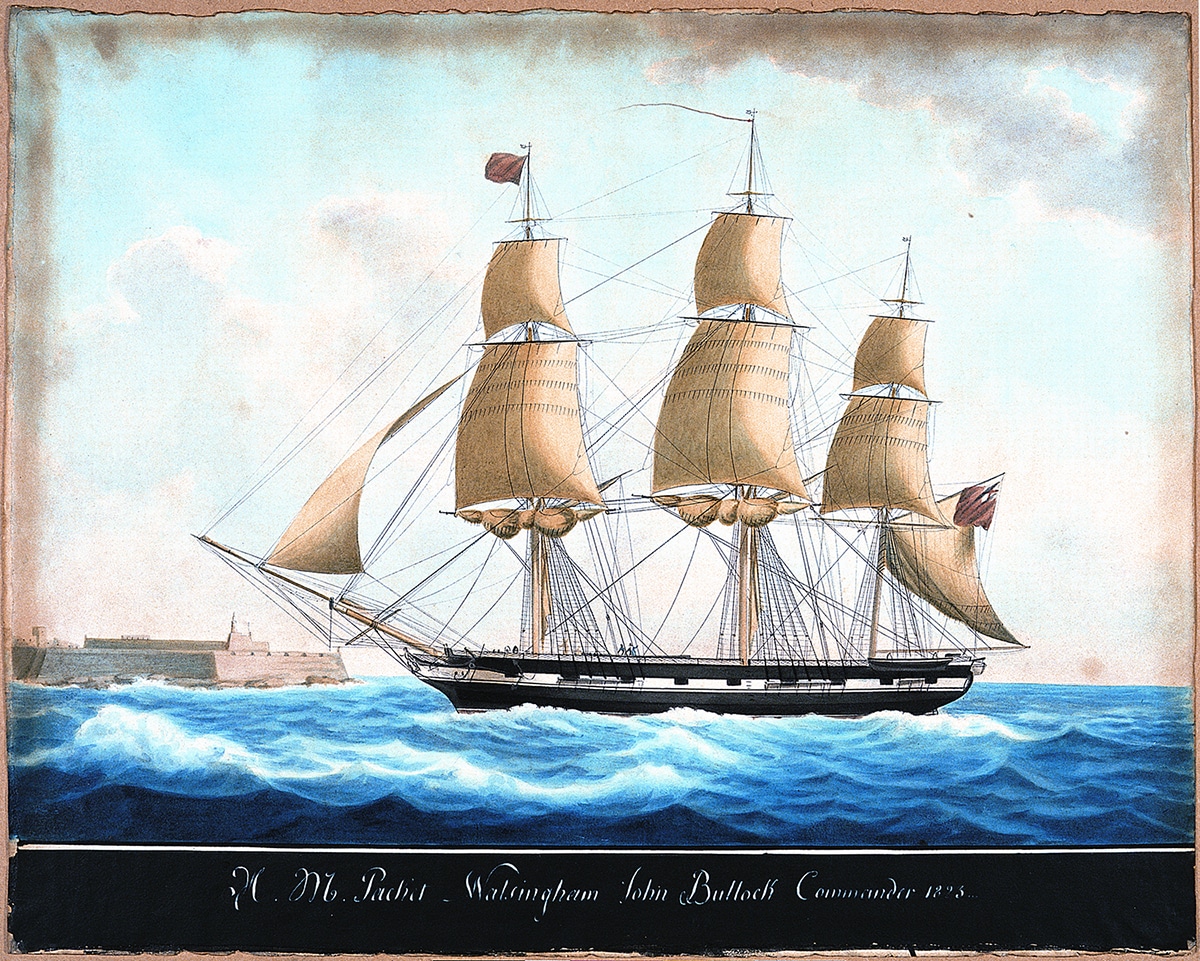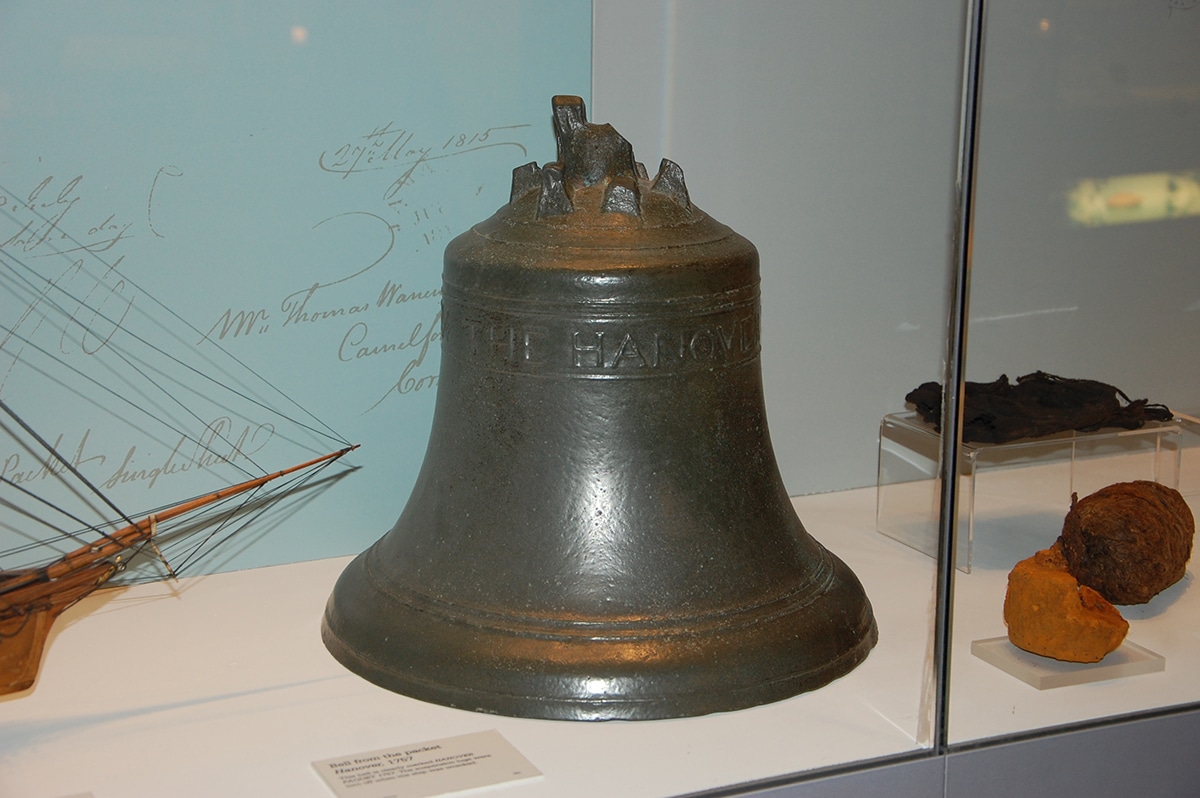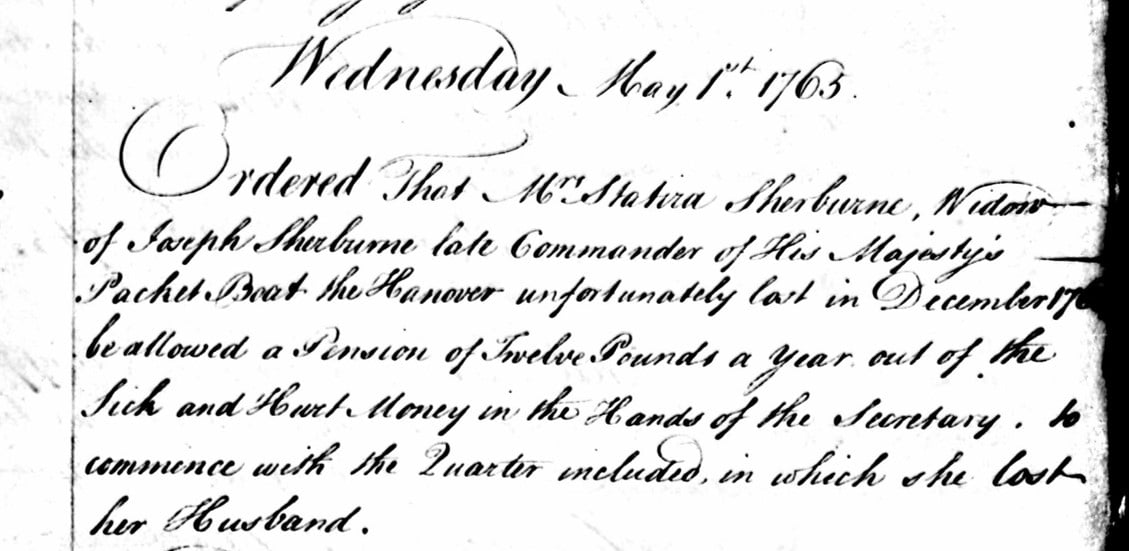

By Linda Batchelor
On New Year’s Day 1764 the burial took place in Falmouth of Captain Joseph Sherburn of His Majesty’s Packet Ship Hanover. The packet ship, returning from Lisbon, was lost on 9th December 1763 in a violent storm off the North coast of Cornwall between St Agnes and Perranporth. Captain Sherburn and all but three of the ship’s complement of crew and passengers were drowned and the captain’s body, identified by the mourning ring that he wore for his first wife, was “cut quite asunder” according to the London Evening Post of 15th December 1763. The packet came to grief in a remote and rugged part of the coast and the cove where the ship sank, previously called Vugga Hayle, is now known as Hanover Cove.

A photograph of Hanover Cove taken in 1994 by George Hogg for National Maritime Museum Cornwall (NMMC)
HMP Hanover was part of the packet fleet based in Falmouth. The Packet Service was established to provide sea links as part of the domestic and international postal service and in 1688 a packet service was established between Falmouth and Corunna in Spain. By 1704 this included a service from Falmouth to Barbados, Jamaica and North America and a service from Falmouth to Lisbon. The service was part of the General Post Office and responsibility lay with the two Post Master Generals who held the positions concurrently and were political appointees. They were supported by a civil servant, the Secretary of the Post Office, based in London and a Packet Agent who was appointed to ensure the smooth running of the Falmouth Packet Station.
Packet vessels were privately owned craft hired by the Post Office from civil contractors and some packet commanders owned or part owned their vessels. The Post Office had the right of approval of appointment for the commanders of the ships but the crews were employed by the ship’s owners. The names of packet ships also required Post Office approval and were often linked to the Royal Family, prominent members of society and Post Master Generals.
The name Hanover was a reference to the ruling royal line and seems to have been introduced in 1712 for the first time for the Hanover(1) packet which was a 120 ton vessel, owned and commanded by Henry Osborne with a crew of 15. The vessel was hired by the Post Office at £75 per lunar month and served on the Lisbon run until 1741.
The replacement Hanover (2) was a Thames built vessel of 150 tons. Owned by Thomas Strickland of London and Anthony Todd and Philip Enouf, both established packet captains resident in Falmouth, this Hanover was commanded by Enouf until he retired in 1754. Command then passed temporarily to the master, Captain Williams, before Joseph Sherburn was commissioned as Commander of this Lisbon packet by the Post Office on 15th September 1755. In March 1757 during the Seven Years War with France Hanover (2) was captured by a French privateer the Comte de Bentem of St Malo. The ship was taken as a prize together with her commander and crew to Brest who were imprisoned in the Castle in Brest and held there for some months before being exchanged and repatriated.
By May 1757 the Post Office had commissioned Hanover (3) to replace the prize loss, newly built in Shoreham as a 100 foot, two masted square rigger. She was brought to Falmouth by Captain Williams and continued under his command on the Lisbon run until the return of Captain Joseph Sherburn who resumed his post as captain in July 1761. In December 1763 the Hanover (3) packet on a return voyage to Falmouth from Lisbon was wrecked off the Cornish coast near St Agnes. Nearly all of the sixty lives on board were lost as was the cargo including a bullion chest containing 20,000 Portuguese moidares worth approximately £27,000.
A temporary Hanover (4) packet was brought in as a replacement almost immediately to be succeeded in 1764 by a 230 ton vessel, Hanover (5) built on the Thames, which remained in service to Lisbon until withdrawn in 1796 and sold out of the service the following year.

Portrait of a packet ship HMP Walsingham by Nicolas Cammillieri. Copyright NMMC.
Joseph was baptised on 21st November 1721 at St Paul’s Covent Garden, Westminster, London, the son of John Sherborn and his wife Mary Dobson. Entries relating to his service with the Post Office Packet service record his surname as Sherburn but other versions refer to him as Sherburne, Sherbon Sherborn and Sherbourne.
Joseph appears to have lived and grown up in Rotherhithe, an area of London close to the Thames, home to many seafarers and with numerous ship building yards. At this time many of the merchant ships of the day, including packet ships, were ‘river built’ and this may have been the route by which Joseph entered a career at sea and the Packet Service.
By 1749 Joseph was living in Falmouth having been appointed as captain of the Falmouth to Corunna packet ship Swallow. In 1744 he had married Mary Spearman in London at St George’s Mayfair, but she had died in 1746. It was the mourning ring that Joseph wore in her memory which enabled his identification after his own death in the shipwreck of 1763.
Joseph had married again in London in 1749 to Statira Fawkner at St Paul’s, Covent Garden, the same year as his appointment to the Swallow. There may have been a connection between the appointment and the marriage to Statira who appears to have been related in some way to Sir Everard Fawkner, Post Master General in 1745. Joseph and Statira had at least six children, all of whom were born and baptised in Falmouth during their father’s career in the Packet Service.
As a packet captain Joseph was soon established as an important figure in Falmouth society and in 1755 was appointed as one of the senior captains in the service on the Falmouth to Lisbon run when he was commissioned as captain of the Hanover (2). It was this vessel which was taken as a prize by a French privateer in 1757. After a period of imprisonment in Brest, Joseph and his crew were repatriated and Joseph took command of the new Hanover (3) in 1758.
HMP Hanover left Falmouth on what was to be her final passage to Lisbon on 28th October 1763 and left Lisbon on the return voyage on 20th November. As well as the official packet letters and documents there were about sixty crew and passengers on board together with a considerable cargo of gold and valuables including the bullion chest. By 8th December the ship was in the western approaches when according to the Annual Register 1763, ‘at night a most furious storm of wind and rain’ developed ‘which did vast damage by sea and land, all over Great Britain and Ireland’.
Captain Sherburn and his crew in the Hanover ran before the storm for Falmouth on the south coast of Cornwall but the ‘irresistible hurricane’ swept the ship past Land’s End and drove her along the north coast of Cornwall. She struck on rocks at the mouth of the cove near St Agnes. The cove is remote, with limited access, isolated by high cliffs and surrounded by jagged rocks. The sea would have been a boiling cauldron of waves and wind which would have caused the ship to have broken up rapidly by the morning of 9th December, ‘the violence of the sea was such, that though a new ship and partly on the sands, she was in ten thousand pieces by next morning’ (The London Evening Post 15 December 1763). The cause of death of many of the casualties was probably the result of being crushed as they were flung upon the rocks. When the captain’s body was washed up, again as reported by the London Evening Post, ‘it was so disfigured as rendered it impossible to know him except as part of his apparel’. There were only three survivors of the wreck – two men and a boy – who were washed up onto the rocks alive but were reported as being so traumatised as being unable to provide any specific details of the wrecking.

The ship’s bell stamped Hanover Packet 1757, probably damaged during the wreck, now on display in the Packet Gallery at National Maritime Museum Cornwall.
Local intelligence informed the Cornish authorities of the loss on 9th December but news of the loss did not reach London until 11th December. The Collector of Customs of St Ives, John Knill and George Bell, the Packet Agent, took charge of the salvage operation. They enrolled sixty ‘tinners’, miners from the district, to provide a guard to stop plunder and to assist with salvage. By 16th December salvage was well underway. Some of the mail, Packet Letters from Oporto and Madeira, was recovered and sent to Exeter but the mail from Lisbon was lost. Some articles of the cargo were washed ashore and gold coins were found on the beach, some probably from the money carried by passengers, but it was initially thought to be the only treasure to be found. As more news arrived however it became clear that the Hanover had been carrying a large quantity of bullion worth a considerable amount of money, especially in contemporary values. A bullion chest was visible at low water but despite an offer of reward attempts at recovery were hampered by tides and weather and the operation to salvage it was abandoned.
After the wreck and the recovery operations were suspended the insurance underwriters paid compensation for the losses but the subsequent recovery of the bullion chest led to the legal case of Da Costa v Firth in 1766. Da Costa, a member of an important mercantile family whose business included brokerage of ship cargoes and bullion, had underwritten an insurance policy on goods and merchandise carried on any of the Packet boats sailing from Lisbon to Falmouth. The policy was in force from 1st October 1763 until 1st October 1764. Firth had an interest in the bullion on board the wrecked Hanover and the insurer Da Costa paid for his loss after the wreck with the proviso that if ’any salvage hereafter be recovered, the insured promises to refund to the insurers whatever he may so recover’.
On 28th April 1765 the iron trunk containing all the bullion was finally recovered intact with salvage costs amounting to £63 8s 2d and returned to the owners. Firth had already received compensation for his proportion of the bullion from Da Costa but failed to refund the amount paid to him under the original agreement. Da Costa took legal action against Firth claiming the right to recover that amount. The case was heard at the Guildhall in London before Lord Mansfield and the decision was given in favour of Da Costa who was entitled to recover the amount, after the deduction for salvage, paid out to Firth for the initial loss. There was also an award of £104 damages and costs of 40s.
The Postal Appointment Book entry for May 1st 1765 below records that the Post Office granted a pension for Statira Sherburne, the Captain’s widow.

The pension was for £12 a year to be paid out of the Post Office funds allocated to the ‘Sick and Hurt Money’ for its employees and was backdated to the time that Statira lost her husband in the wreck.
Although the cove where the Hanover sank is not far from the beaches at St Agnes or Perranporth it is still remote and on a hazardous part of the coast. The cliffs are high and sheer and the small beach is difficult to reach. The sea conditions at the time of the wreck were and still can be calamitous and the ship must have broken up rapidly and the wreckage been widely distributed. In 1994 remains of the ship were located by Colin Martin, owner of a Cornish marine salvage company, who set up a separate company in 1995 to salvage the wreck but since 1997 no further work has been undertaken on the site. The sea and the return of the sand once again cover the remains and the site is now a Protected Wreck managed by Heritage England.
The chief legacy of the loss of the Hanover is that, as well as being part of the history of the Falmouth Packet Service, since that loss the cove has borne the name of the ship as Hanover Cove.
Find out more about the treasures of the Hanover, including objects on display at the Museum, with our Curator’s Choice blog post here.
The Bartlett Blog is written and produced by the volunteers who staff The Bartlett Maritime Research Centre and Library of National Maritime Museum Cornwall. The Loss of the Packet Ship Hanover was written by Linda Batchelor.
The Bartlett Library holds a Collection of over 20,000 volumes and offers access to one of the finest collections of maritime reference books, periodicals and archival material. The Bartlett Blog reflects the diversity of material available in The Bartlett Library.

National Maritime
Museum Cornwall Trust
Discovery Quay
Falmouth Cornwall
TR11 3QY
View Map
See our opening hours
Tel: +44(0)1326 313388
Email: enquiries@nmmc.co.uk